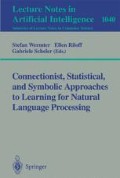Abstract
In this paper we describe a screening approach for speech/language analysis using learned, flat connectionist representations. For investigating this approach we built a hybrid connectionist system using a large number of connectionist and symbolic modules. Our system SCREEN learns a flat syntactic and semantic analysis of incremental streams of word hypothesis sequences. In this paper we focus on techniques for improving the quality of pruned hypotheses from a speech recognizer using acoustic, syntactic, and semantic knowledge. We show that the developed architecture is able to cope with real-world spontaneously spoken language in an incremental and parallel manner.
Preview
Unable to display preview. Download preview PDF.
References
J. W. Amtrup. ICE: INTARC communication environment. User guide and reference manual. VM-Techdok 14, Universität Hamburg, November 1994.
J. W. Amtrup, A. Hauenstein, C. Pyka, V. Weber, S. Wermter. An outline of the Verbmobil project with focus on the work at the University of Hamburg. In P. Mc Kevitt, ed., Proceedings of the AAAI-94 Workshop on Integration of Natural Language and Speech Processing. Seattle, Washington, USA, August 1994.
J. L. Elman. Finding structure in time. Cognitive Science, 14(2):179–211, 1990.
S. J. Hanson, J. Kegl. PARSNIP: A connectionist network that learns natural language grammar from exposure to natural language sentences. In Proceedings of the 9th Annual Conference of the Cognitive Science Society, pp. 106–119. Seattle, Washington, 1987.
A. Hauenstein, H. H. Weber. An investigation of tightly coupled time synchronous speech language interfaces using a unification grammar. In Proceedings of the AAAI-94 Workshop on the Integration of Natural Language and Speech Processing. Seattle, Washington, 1994.
T. Howells. VITAL: A connectionist parser. In Proceedings of the 10th Meeting of the Cognitive Science Society, pp. 18–25. Montreal, Canada, 1988.
A. N. Jain. Generalization performance in PARSEC — a structured connectionist parsing architecture. In J. E. Moody, S. J. Hanson, R. R. Lippmann, eds., Advances in Neural Information Processing Systems 4, pp. 209–216. Morgan Kaufmann, San Mateo, CA, 1992.
D. Jurafsky, C. Wooters, G. Tajchman, J. Segal, A. Stolcke, N. Morgan. Integrating experimental models of syntax, phonology, and accent/dialect in a speech recognizer. In Proceedings of the AAAI-94 Workshop on the Integration of Natural Language and Speech Processing. Seattle, Washington, July/August 1994.
J. L. McClelland, A. H. Kawamoto. Mechanisms of sentence processing: Assigning roles to constituents of sentences. In J. L. McClelland, D. E. Rumelhart, The PDP research group, eds., Parallel Distributed Processing: Explorations in the Microstructure of Cognition, vol. 2., Psychological and Biological Models, chapter 19, pp. 272–331. MIT Press, Cambridge, MA, 1986.
C. McMillan, M. C. Mozer, P. Smolensky. Rule induction through integrated symbolic and subsymbolic processing. In J. E. Moody, S. J. Hanson, R. P. Lippmann, eds., Advances in Neural Information Processing Systems 4, pp. 969–976. Morgan Kaufmann, San Mateo, CA, 1992.
C. S. Mellish. Some chart-based techniques for parsing ill-formed input. In Proceedings of the 27th Annual Meeting of the Association for Computational Linguistics, pp. 102–109, 1989.
R. Miikkulainen. Subsymbolic Natural Language Processing. An integrated model of scripts, lexicon and memory. MIT Press, Bradford Book, Cambridge, MA, 1993.
M. C. Mozer. Neural net architecture for temporal sequence processing. In A. Weigend, N. Gershenfeld, eds., Predicting the future and understanding the past. Addison-Wesley Publishing, Redwood City, CA, February 1993.
R. Sun. Integrating Rules and Connectionism for Robust Common Sense Reasoning. Wiley and Sons, New York, 1994.
G. Towell, J. W. Shavlik. Interpretation of artificial networks: Mapping knowledge-based neural networks into rules. In J. E. Moody, S. J. Hanson, R. R. Lippmann, eds., Advances in Neural Information Processing Systems 4, pp. 977–984. Morgan Kaufmann, San Mateo, CA, 1992.
W. von Hahn, C. Pyka. System architectures for speech understanding and language processing. In G. Heyer, H. Haugeneder, eds., Appl. Ling. Wiesbaden, 1992.
A. Waibel, A. N. Jain, A. McNair, J. Tebelskis, L. Osterholtz, H. Saito, O. Schmidbauer, T. Sloboda, M. Woszczyna. JANUS: Speech-to-speech translation using connectionist and non-connectionist techniques. In J. E. Moody, S. J. Hanson, R. R. Lippmann, eds., Advances in Neural Information Processing Systems 4, pp. 183–190. Morgan Kaufmann, San Mateo, CA, 1992.
N. Ward. An approach to tightly-coupled syntactic/semantic processing for speech understanding. In Proceedings of the AAAI-94 Workshop on the Integration of Natural Language and Speech Processing. Seattle, Washington, 1994.
V. Weber, S. Wermter. Artificial neural networks for repairing language. In Proceedings of the 8th International Conference on Neural Networks and their Applications. Marseilles, FRA, December 1995.
V. Weber, S. Wermter. Towards learning semantics of spontaneous dialog utterances in a hybrid framework. In J. Hallam, ed., Hybrid Problems, Hybrid Solutions — Proceedings of the 10th Biennial Conference on AI and Cognitive Science, pp. 229–238. Sheffield, UK, 1995.
S. Wermter, M. Löchel. Connectionist learning of flat syntactic analysis for speech/language systems. In M. Marinaro, P. G. Morasso, eds., Proceedings of the International Conference on Artificial Neural Networks, vol. 2, pp. 941–944. Sorrento, Italy, 1994.
S. Wermter, U. Peters. Learning incremental case assignment based on modular connectionist knowledge sources. In P. Werbos, H. Szu, B. Widrow, eds., Proceedings of the World Congress on Neural Networks, vol. 4, pp. 538–532. San Diego, CA, 1994.
S. Wermter, V. Weber. Learning fault-tolerant speech parsing with SCREEN. In Proceedings of the 12th National Conference on Artificial Intelligence, vol. 1, pp. 670–675. Seattle, Washington, 1994.
S. Wermter, V. Weber. Artificial neural networks for automatic knowledge acquisition in multiple real-world language domains. In Proceedings of the 8th International Conference on Neural Networks and their Applications. Marseilles, FRA, December 1995.
S. Wermter. Hybrid Connectionist Natural Language Processing. Chapman and Hall, London, UK, 1995.
Author information
Authors and Affiliations
Editor information
Rights and permissions
Copyright information
© 1996 Springer-Verlag Berlin Heidelberg
About this paper
Cite this paper
Weber, V., Wermter, S. (1996). Using hybrid connectionist learning for speech/language analysis. In: Wermter, S., Riloff, E., Scheler, G. (eds) Connectionist, Statistical and Symbolic Approaches to Learning for Natural Language Processing. IJCAI 1995. Lecture Notes in Computer Science, vol 1040. Springer, Berlin, Heidelberg. https://doi.org/10.1007/3-540-60925-3_40
Download citation
DOI: https://doi.org/10.1007/3-540-60925-3_40
Published:
Publisher Name: Springer, Berlin, Heidelberg
Print ISBN: 978-3-540-60925-4
Online ISBN: 978-3-540-49738-7
eBook Packages: Springer Book Archive

